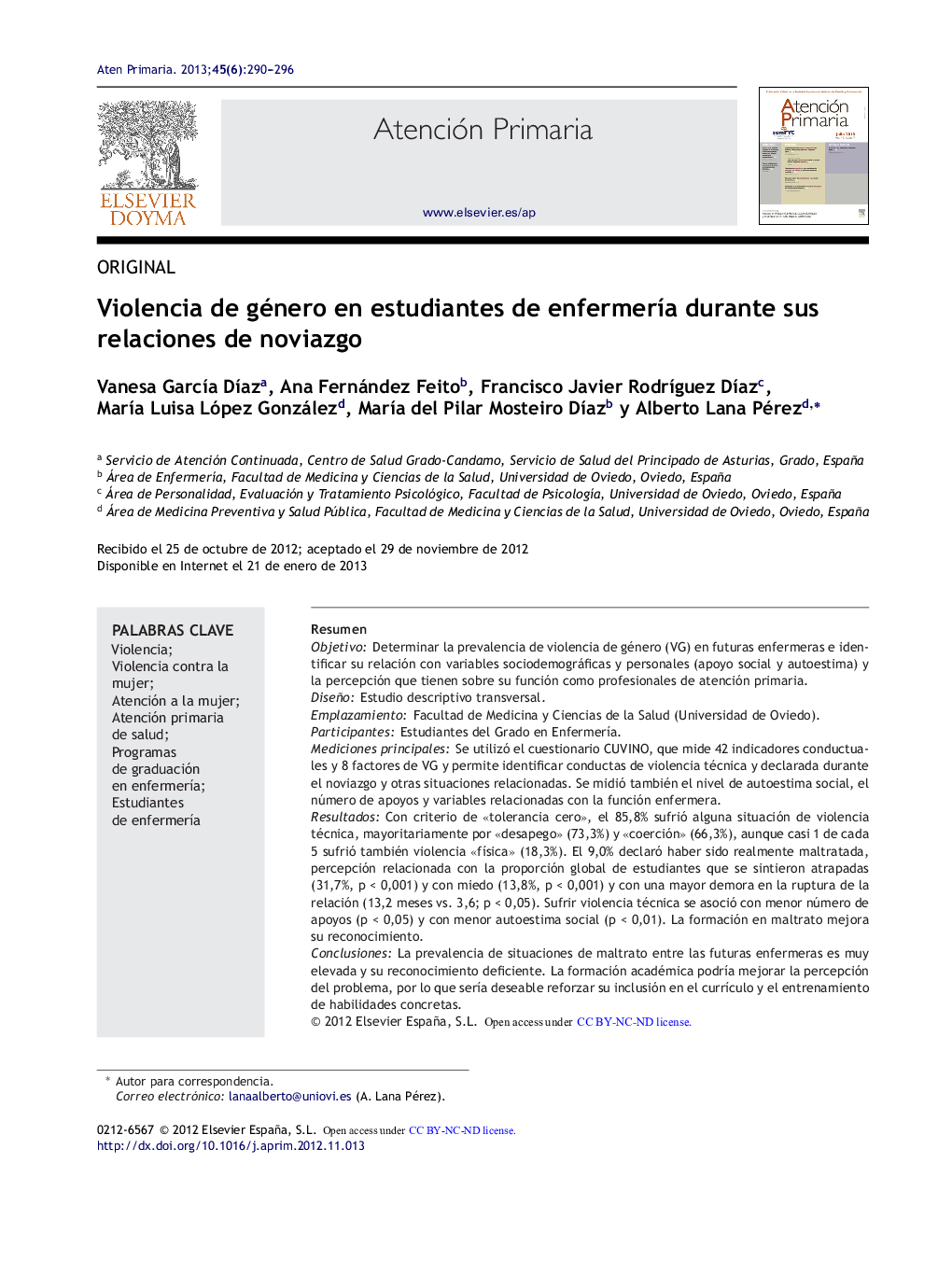| کد مقاله | کد نشریه | سال انتشار | مقاله انگلیسی | نسخه تمام متن |
|---|---|---|---|---|
| 3457434 | 1230909 | 2013 | 7 صفحه PDF | دانلود رایگان |

ResumenObjetivoDeterminar la prevalencia de violencia de género (VG) en futuras enfermeras e identificar su relación con variables sociodemográficas y personales (apoyo social y autoestima) y la percepción que tienen sobre su función como profesionales de atención primaria.DiseñoEstudio descriptivo transversal.EmplazamientoFacultad de Medicina y Ciencias de la Salud (Universidad de Oviedo).ParticipantesEstudiantes del Grado en Enfermería.Mediciones principalesSe utilizó el cuestionario CUVINO, que mide 42 indicadores conductuales y 8 factores de VG y permite identificar conductas de violencia técnica y declarada durante el noviazgo y otras situaciones relacionadas. Se midió también el nivel de autoestima social, el número de apoyos y variables relacionadas con la función enfermera.ResultadosCon criterio de «tolerancia cero», el 85,8% sufrió alguna situación de violencia técnica, mayoritariamente por «desapego» (73,3%) y «coerción» (66,3%), aunque casi 1 de cada 5 sufrió también violencia «física» (18,3%). El 9,0% declaró haber sido realmente maltratada, percepción relacionada con la proporción global de estudiantes que se sintieron atrapadas (31,7%, p < 0,001) y con miedo (13,8%, p < 0,001) y con una mayor demora en la ruptura de la relación (13,2 meses vs. 3,6; p < 0,05). Sufrir violencia técnica se asoció con menor número de apoyos (p < 0,05) y con menor autoestima social (p < 0,01). La formación en maltrato mejora su reconocimiento.ConclusionesLa prevalencia de situaciones de maltrato entre las futuras enfermeras es muy elevada y su reconocimiento deficiente. La formación académica podría mejorar la percepción del problema, por lo que sería deseable reforzar su inclusión en el currículo y el entrenamiento de habilidades concretas.
AimTo determine the prevalence of gender violence (GV) suffered by student nurses and to identify its relationship with some sociodemographic and personal variables (social support and self-esteem) and their perception about their role as primary care providers.DesignCross-sectional study.LocationFaculty of Medicine and Health Sciences (University of Oviedo).ParticipantsNursing students.Main measurementsThe CUVINO questionnaire was used. It measures 42 behavioral indicators and 8 GV factors and allows to identify technical and perceived violence during courtship and other related situations. The level of social self-esteem, support and variables related with the nursing role were also measured.ResultsUsing the standard of “zero tolerance”, 85.8% suffered technical violence, mainly by “detachment” and “coercion” (73.3%), while almost 1 in 5 also suffered “physical” violence (18.3%). A lower percentage (9.0%) reported having been really ill-treated, perception related to the global proportion of students who felt trapped (31.7%, P <.001), felt fear (13.8%, P <.001) and a further delay in breaking the relationship (13.2 months vs. 3.6; P <.05). Suffering technical violence was associated with less social support (P <.05) and less social self-esteem (P <.01). Academic training in GV improves recognition.ConclusionsThe prevalence of GV situations between student nurses is very high and recognition is poor. Academic training could improve the perception of the problem, thus it would be desirable to strengthen its inclusion in the university curriculum, together with specific skills training.
Journal: Atención Primaria - Volume 45, Issue 6, June–July 2013, Pages 290–296